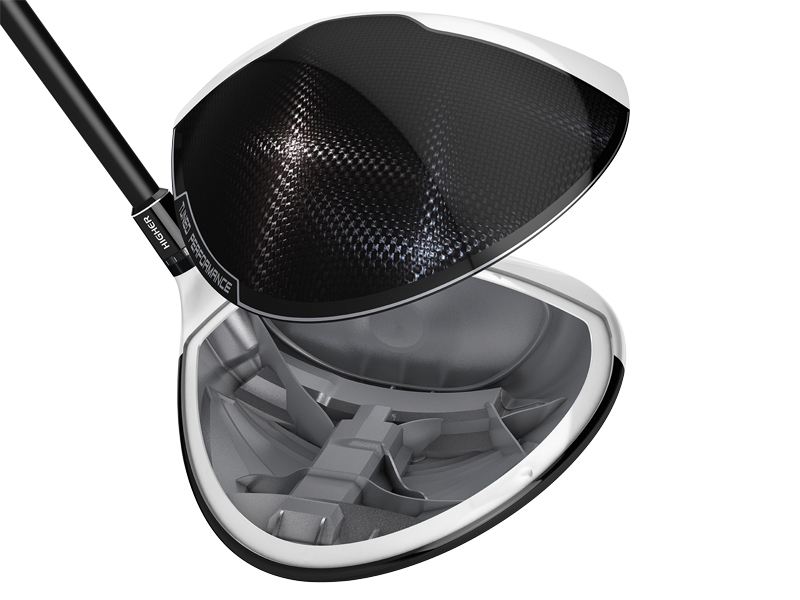Tech explained... graphite crowns
The unsung heroes that lead to big gains in distance and forgiveness


Graphite crowns are the unsung heroes that lead to big gains in distance and forgiveness
Tech explained... graphite crowns
Although it’s the clubface that makes contact with the ball, the crown is one of the most important areas of your driver’s anatomy and manufacturers devote a significant amount of time, research and development into perfecting it. Not only does the crown affect the club’s aerodynamics during the swing, it is here that valuable weight savings can be made in order to move the CG lower and make the clubhead more forgiving.
But how? Many crowns on the shelf of your pro shop may appear similar to the naked eye, but things have developed significantly in recent years. Graphite, first seen in the early 2000s, is chosen over titanium because of its high strength and stiffness with a low density – highly desirable when building golf clubs.
Carbon composite in practice
The launch of the TaylorMade M1 driver has thrust graphite, or ‘carbon composite’ crowns into the limelight once again. The company says it’s been working on the M1’s technology for over a decade, reducing the crown’s weight down to 10g, allowing it to implement two weight tracks on the sole.
Related: TaylorMade driver review
The M1’s crown is made of seven 0.1mm layers orientated in different ways to maximise strength. The manufacturing limit of titanium over the crown and sole is 0.5mm, so it’s a technique TaylorMade is rightly proud of.
Get the Golf Monthly Newsletter
Subscribe to the Golf Monthly newsletter to stay up to date with all the latest tour news, equipment news, reviews, head-to-heads and buyer’s guides from our team of experienced experts.
“We developed our own process for ultra-thin ply graphite composites technology,” Todd Beach, vice president of metalwoods R&D for TaylorMade, told GM. “These composite plies are about half the thickness of a typical composite used in other golf clubs. This enables us to have more layers with a higher-strength, thinner overall composite that can free weight from an already weight-efficient titanium crown. This material is much more difficult to produce because of the precision required.”
Cobra is another brand releasing new crown innovations this year with the launch of the King LTD driver (right). Here, the TeXtreme carbon fibre creates a crown that is 20 per cent lighter than regular carbon fibre. It uses straighter fibres that make it possible to achieve thinner laminates and use less plastic to bond them together, thus reducing weight but maintaining strength.
Yonex has been at the forefront of graphite technology for decades. The Cyberstar Powerbrid driver launched in 2003 was its first to feature a carbon composite crown. This year, it’s new Ezone XPG driver has an even lighter crown that has enabled two weights to go inside the head to move the CG lower and further back, increasing forgiveness.
Strength
While needing to be extremely lightweight, graphite driver crowns also need to be strong. The level of this strength needs to strike a balance to ensure the crown stays in one piece during knocks and bumps in your golf bag, but offers enough give at impact to minimise ball-speed loss on high-face impacts.
The crown does flex at impact, but developments in the resins used to bond the materials together mean there’s more flexibility when it comes to crown design and managing strength and durability.
Aerodynamics
Not only do crowns serve the purpose of saving weight but they can also improve a club’s aerodynamics. We’ve seen this in models like the Ping G30 and Callaway XR drivers, where raised sections improve the air flow over the top of the head.
So the next time you look down at your driver, spare a thought for the man hours and research that have gone into making it perform for you!

Nick Bonfield joined Golf Monthly in 2012 after graduating from Exeter University and earning an NCTJ-accredited journalism diploma from News Associates in Wimbledon. He is responsible for managing production of the magazine, sub-editing, writing, commissioning and coordinating all features across print and online. Most of his online work is opinion-based and typically centres around the Majors and significant events in the global golfing calendar. Nick has been an avid golf fan since the age of ten and became obsessed with the professional game after watching Mike Weir and Shaun Micheel win The Masters and PGA Championship respectively in 2003. In his time with Golf Monthly, he's interviewed the likes of Rory McIlroy, Justin Rose, Jose Maria Olazabal, Henrik Stenson, Padraig Harrington, Lee Westwood and Billy Horschel and has ghost-written columns for Westwood, Wayne Riley, Matthew Southgate, Chris Wood and Eddie Pepperell. Nick is a 12-handicap golfer and his favourite courses include Old Head, Sunningdale New, Penha Longha, Valderrama and Bearwood Lakes. If you have a feature pitch for Nick, please email nick.bonfield@futurenet.com with 'Pitch' in the subject line. Nick is currently playing: Driver: TaylorMade M1 Fairway wood: TaylorMade RBZ Stage 2 Hybrid: Ping Crossover Irons (4-9): Nike Vapor Speed Wedges: Cleveland CBX Full Face, 56˚, Titleist Vokey SM4, 60˚ Putter: testing in progress! Ball: TaylorMade TP5x
-
 Rory McIlroy Wins The Masters In Playoff To Complete Career Grand Slam
Rory McIlroy Wins The Masters In Playoff To Complete Career Grand SlamThe Northern Irishman battled past Ryder Cup teammate, Justin Rose to finally seal his first Masters title and become the sixth man to win all four men's Majors
By Jonny Leighfield Published
-
 Did You Know The Masters Leaderboard Was Inspired By Fenway Park?
Did You Know The Masters Leaderboard Was Inspired By Fenway Park?The Masters leaderboards are an iconic and historic part of the Augusta National Major, but did you know about its origins and how it operates today?
By Matt Cradock Published